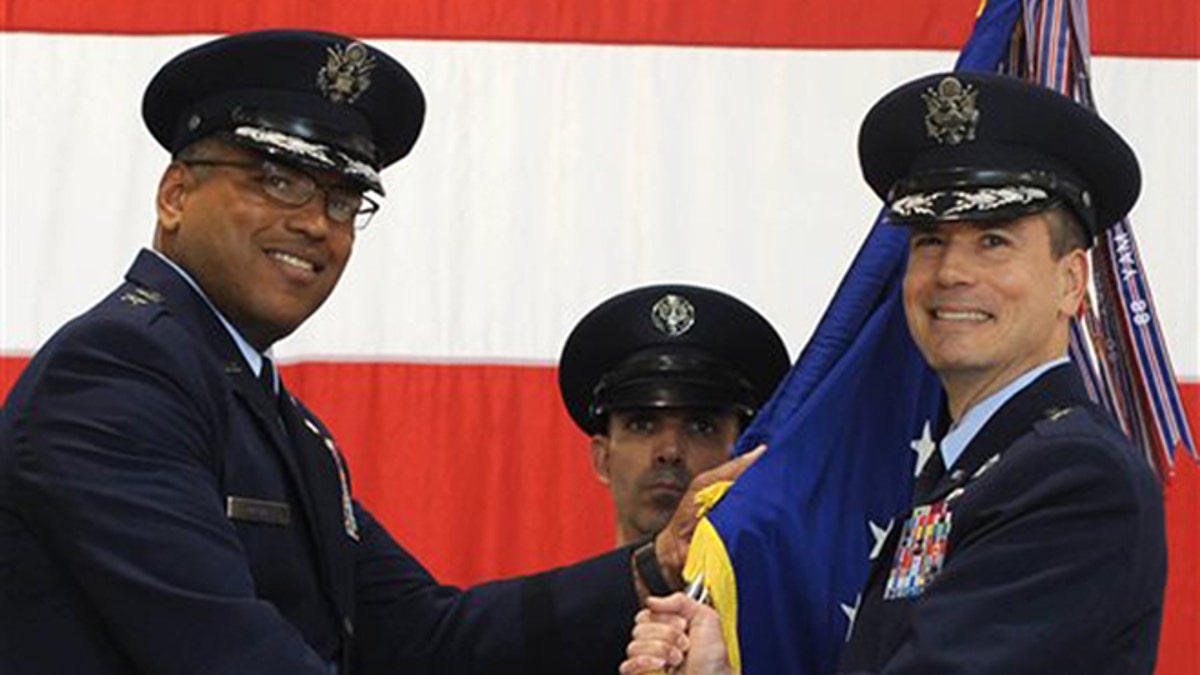
In this photo provided by the U.S. Air Force, Brig. Gen. Paul W. Tibbets IV, right, receives the the 509th Bomb Wing guidon from Air Force Maj. Gen. Richard Clark, left, to take over leadership of the United States' aging fleet of nuclear-capable B-2 stealth bombers at Whiteman Air Force Base, Mo. (Staff Sgt. Alexandra M. Longfellow/U.S. Air Force via AP)
A grandson and namesake of the man who piloted the B-29 that dropped the atomic bomb on Hiroshima, Japan, during World War II took over leadership Friday of the United States' aging fleet of nuclear-capable B-2 stealth bombers.
Brig. Gen. Paul W. Tibbets IV took command of the 509th Bomb Wing during a ceremony at Whiteman Air Force Base in Missouri, replacing Brig. Gen. Glen VanHerck, who has led the wing since February 2014.
Tibbets' grandfather, Paul W. Tibbets Jr., was assigned to a predecessor of the 509th Bomb Wing when he piloted the Enola Gay in the world's first atomic bomb mission on Aug. 6, 1945. The bomb destroyed much of Hiroshima and killed tens of thousands of its citizens. Paul W. Tibbets Jr. died in 2007.
The government in Japan has said that thousands of people have been categorized as still sick from the Hiroshima bombing's radiation.
Three days after Hiroshima another U.S. B-29 dropped an atomic bomb on Nagasaki, killing about 70,000 people. Japan surrendered six days later, ending the war.
Tibbets told about 500 people attending the ceremony in a hangar at the base that his grandfather would be "touched by your appreciation for his service and the service of those that he was with back in that time."
His grandfather would also tell them, Tibbets said, that "he's counting on you, he's counting on us, today's generation of airmen, to continue as you do each and every day to raise the bar and set the standard and continue the great work that our nation relies on us to to do."
Tibbets, 48, previously served as deputy director for nuclear operations for the U.S. Strategic Command at Offutt Air Force Base in Nebraska. He also trained on B-2s at Whiteman in the 1990s, commanded a bomb squadron at the base and was a vice commander of the 379th Air Expeditionary Wing in southwest Asia in 2010-2011. His awards include the Distinguished Flying Cross, the Bronze Star for service and the Legion of Merit.
The Bomb Wing at Whiteman is responsible for flying the fleet of 20 nuclear-capable B-2 stealth bombers to targets around the world, often directly. The B-2, which has been at the Missouri base since 1993, has been flying since the 1990s and is still the world's only long-range bomber with technology that makes the batwing aircraft difficult for radar to detect and track.
Paul W. Tibbets IV's role leading the 509th Bomb Wing comes as the Air Force has been seeking to build a next-generation long-strike bomber, estimated to cost at least $55 billion for up to 100 planes.
A 2014 report from the Congressional Research Service said the nation's existing long-range bomber fleet "are at a critical point in their operational life span." Because of their age, the report said, "military analysts are beginning to question just how long these aircraft can physically last and continue to be credible weapon systems."
It's unclear how many B-2s or other bombers would be replaced under any new bomber program.




